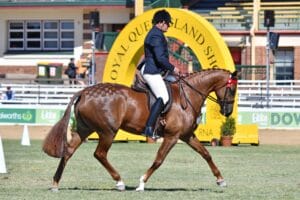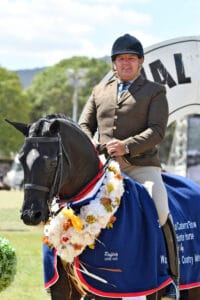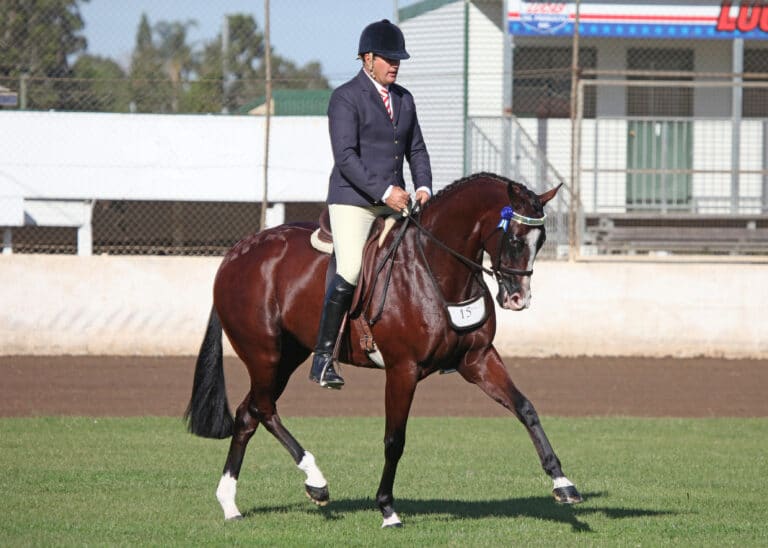Renowned for his extensive showing knowledge, Paul Austin’s name is synonymous with the show ring. He talks to CHRISTINE ARMISHAW about some of the secrets behind his success.
The perfect show horse could be described as the Elle MacPherson or Claudia Schiffer of the equine world: beautiful, eye catching, and with that unmistakable ‘wow’ factor.
And that’s what show horse champion Paul Austin looks for when he’s searching for his next top ‘model’. “It needs to have a pretty head, a good length of rein, be able to move well and cover ground, but it’s got to have a brain as well. A great temperament is number one, but you still need quality to have an amazing show horse,” Paul tells me, and having consistently taken unbroken or green horses right up through the ranks to wins and Champions at Royal Show level, he should know.
Paul, who has been riding since he was nine, started out doing everything from Pony Club, games and dressage, to hunting and eventing, before gravitating to showing. As more and more of his clients requested his expertise in that field, the die was cast. In fact, he made the big move from Victoria to Queensland after a client regularly flew him up for coaching lessons, show preparation and horse shopping. “After coming up so often to do all that teaching and coaching, I decided to move. I love it up here. The weather is great, it’s really good for working horses compared to Melbourne’s four seasons in one day,” he says.
While he lived in Melbourne Paul trained in dressage with Olympian Mary Hanna, a discipline he believes gives a solid foundation for success in the show ring. “To switch into showing mode, I just add a bit of bling; a browband, the make-up, some patterns, and off we go!”
Paul takes a team of his own and his clients’ horses and travels up and down the east coast of Australia attending all the major Royal and Grand National shows in Brisbane, Sydney, Canberra and Adelaide, as well as many others in between. The show horse life has Paul out on the road showing, travelling and teaching for weeks on end before coming home to pick up the next string of horses and heading off again.
Preparation is a lifestyle
Paul explains that to be successful, preparation should begin long before the event if you want to have your horse looking their very best: “Our horses are surveyed every day and assessed for body condition. Do they need more feed? Do they need less? Do they need a different rug on because it’s rubbing? Are they happy in that paddock? Are they eating properly? You’ve got to keep on top of it. You’re looking ahead, preparing for that show coming up in eight weeks or so, not just for today.”
With around twenty horses at his property in Tamborine, Paul says he and his team are always busy. A handful of horses are turned out spelling and the other sixteen are in full work and treated like movie stars: “Our horses are out in their own paddocks during the day and brought in at night, which helps rest the paddocks. They’re turned out for breakfast and rug layers are taken off according to temperature. Most horses are worked Monday to Friday, with my two wonderful grooms each tacking up a horse for me to ride, then ungearing, hosing and re-rugging after the horse has been worked.”

Paul with Dunelm Last Dance, twice Grand National winning Lead Rein Pony (Image by SWD Images)
Paul likens the approach to a well-oiled production line: “Each horse has its tail brushed regularly, has hoof oil applied three times per week, and gets washed once a week, as do their cotton rugs,” he tells me, emphasising the point that meticulous routine is essential to successful show preparation.
In the evenings the horses are fed dinner and rugged. Each one is treated as an individual, with a feed and rugging regime to suit. “The horses come back into the stable under lights so they have a longer day, which, combined with correct rugging, means their hair stays shorter and they have better coats. While inside, there are fans on when it’s warm because we don’t want them to get so hot that they sweat,” Paul explains. “Our horses only have on one neck rug or hood, otherwise there’s too much weight on the neck, which can rub out the mane. Plus there’s a risk that if multiple hoods are used, one of the layers can get pulled over the horse’s eyes.”
Work it
Aside from working a multitude of horses, Paul also fits in a daily gym session to keep himself in shape, then keeps going until dusk teaching his many regular clients. When he’s not at home, he regularly coaches throughout Australia and New Zealand, teaching dressage as well as good basic riding techniques such as using the legs and seat instead of relying on the hands.
As you might expect, looks are very important in the show ring. But Paul, who also judges show horses, says the ratio is about sixty per cent beauty to forty per cent movement. The way the horse moves is crucial to achieving a great result, and he has a specific training system that encourages his horses to develop into the ideal show horse shape. “We work our horses as low as we can while still holding a contact. You see a lot of horses out there competing that are very hollow in the back and not engaging and using their back end. They’re very soft or weak over the back, and it’s like a broken bridge. We work our horses so they gain strength and muscle over the back,” he explains, “they’re fit from being worked every week day, plus we mix it up with pole work and go out on trail rides too.”
Paul tells me that the week before a show, the horse’s workload is lightened to around fifteen minutes a day, so when they arrive at the venue it doesn’t take much to get them settled and ready to perform. “At the big shows like the Royals, there’s a lot of atmosphere. Ferris wheels, motorbikes, there’s everything going on, which is a lot to take in and the horse can get a bit tense. So, if they need a bit of work to settle, it’s better to have them not quite as fit as usual. Otherwise it takes longer to work a horse down before heading into the ring.”

Showing tips to live by
With such a wealth of knowledge at his fingertips, it’s hard to pin down just a few key points, but Paul is happy to share his best advice for anyone wanting to get into the world of showing and do well.
Perhaps most important is to plan and prepare everything you do. You’re not going to get there overnight, you’re on a journey. So give your horse plenty of time and adequately prepare them. “You’ve got to prepare plenty of weeks ahead to have your horse looking schmick,” Paul says. “A lot of people take their horses out when they’re not ready. You need condition, you need top line, you need everything built together to make that picture perfect show horse.”

The magnificent Dicavalli Rory, a multi Royal and National winner, owned and adored by The Lovell Family (Image courtesy Paul Austin Equitation).
Next point to ponder, don’t over face yourself or your horse. When you get a new horse, allow at least six weeks for you to get to know each other before heading out to a show and, as with any horse, make sure it’s going well in training first. In Paul’s expert opinion: “If you’re not getting the correct lead, or your horse isn’t going well at home, it’s not ready to take out to a show.”
And finally, make sure your number one accessory is your horse. “You’ll see the girl who rocks up to the show who’s got the red browband on the horse and she’s carrying a red cane. She’ll have a red tie, along with a red collar on her jacket, be wearing red pumps and she’ll have red gloves on too. And do you know what?” Paul gives a wry chuckle, “the focus is on her, not on her horse, and it should always be on the horse. Go back to basics, follow tradition. A lot of people try to bling it up too much, but remember, less is more.”
For more information, visit paulaustinequitation.com.au – and be sure not to miss Paul’s additional tips over at the Equestrian Hub’s VIP area: https://equestrianhub.com.au/vip-member/
Feature Image Lisa and Courtney Bird’s Marquise was difficult at first but won at Royals all the way through to Runner Up at the Grand Nationals (Image by Bridey Lee Photography).



